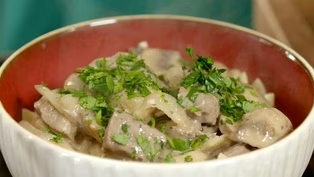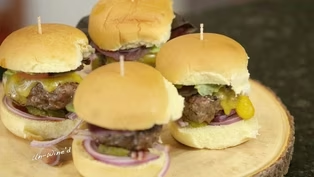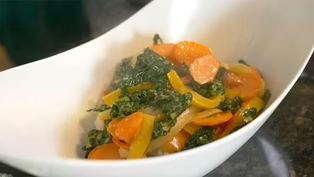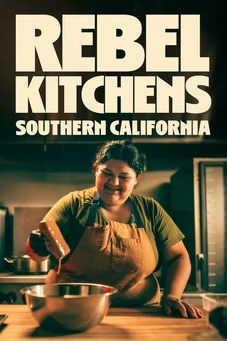Un-Wine'd
American Viticulture Area: Virginia's AVA
Season 3 Episode 6 | 26m 47sVideo has Closed Captions
An AVA is designated to grow grapes based on cultures which are unique to those areas.
What is an AVA (American Viticulture Area)? Each area is designated to grow grapes based on cultures which are unique to those areas for a successful crop. Tassie will show us how to prepare Vegetable Red Curry, Beef Stroganoff and Sweet and Spicy Bacon Cheddar Sliders with Smoked Maple BBQ Sauce.
Problems playing video? | Closed Captioning Feedback
Problems playing video? | Closed Captioning Feedback
Un-Wine'd is a local public television program presented by VPM
Un-Wine'd
American Viticulture Area: Virginia's AVA
Season 3 Episode 6 | 26m 47sVideo has Closed Captions
What is an AVA (American Viticulture Area)? Each area is designated to grow grapes based on cultures which are unique to those areas for a successful crop. Tassie will show us how to prepare Vegetable Red Curry, Beef Stroganoff and Sweet and Spicy Bacon Cheddar Sliders with Smoked Maple BBQ Sauce.
Problems playing video? | Closed Captioning Feedback
How to Watch Un-Wine'd
Un-Wine'd is available to stream on pbs.org and the free PBS App, available on iPhone, Apple TV, Android TV, Android smartphones, Amazon Fire TV, Amazon Fire Tablet, Roku, Samsung Smart TV, and Vizio.
Providing Support for PBS.org
Learn Moreabout PBS online sponsorship>>Hi, I'm Tassie Pippert (upbeat jazzy music) and on today's show, you'll learn about American Viticultural Areas, AVAs, right here in Virginia.
We'll talk to some experts and you'll taste some delicious foods and wines from throughout the Virginia AVAs.
So don't go away.
Grab your glass, it's always time to "Un-wine'd".
>>Production funding for "Un-wine'd" was made possible in part by... (upbeat jazzy music continues) (lively dramatic music) >>Virginia has American Viticultural Areas.
These are distinctive areas marked by climate, soils, temperatures, they all go together to make a very different grape.
So on today's show, we're going to talk a little bit about the distinct differences in those AVAs with Sally Cowal, Doug Flemer, and Richard Leahy.
So join me now in the kitchen as I pair delicious foods with distinctively different wines from the AVAs of Virginia.
I love this Foothills Early Mountain.
It is so delicious.
And it just shows us how the AVA can really play into the blend of wine.
So in Madison, where Early Mountain is located, they grow lots of Cabernet Franc, Merlot, Cabernet Sauvignon, Tannat, a little bit of Petit Verdot, and some Petit Manseng, all of which go into this delicious wine.
For right now, I'm going to make some cheddar sliders.
These are wonderful bacon cheddar sliders, so delicious.
And we're gonna start off (light upbeat music) with a little spicy barbecue sauce.
So in my pan, I have eight ounces of tomato sauce, just eight ounces.
That's one of those smaller cans of tomato sauce.
And to that I'm going to add about 1/3 cup of maple syrup.
So this is going to be our delicious sweetener in this.
Love these flavors together.
About three tablespoons of Dijon mustard, which will give it a real richness that's totally different than a thin barbecue sauce.
And then I wanna add some cider vinegar.
I love a good apple cider vinegar and I try to buy local when I can.
A little bit of Tabasco just to give it a little bit of heat but you don't have to put the Tabasco in it if you don't like the heat.
A little bit of onion salt and I like to use onion salt and garlic salt in this because it adds a little bit of saltiness.
Now remember, the Dijon also has salt in it, so before you add any additional salt, make sure you taste it.
A little bit of Worcestershire and some smoked paprika.
This is where the smoked comes from.
Mm, so good.
Let's just kinda stir all that up.
And then I'm gonna put it over on the cooktop to heat.
Now, in my bowl, I have some really lean ground beef.
I like to use something that's maybe 92% lean, 90% lean because we're going to add bacon fat to this and when we do that, that's where our juiciness, that wonderful fat will come from.
So I just wanna pull this all apart.
This happens to be a 92% lean, 8% fat.
Just pull all that apart.
And then I'm going to add about six slices of bacon that I've finely minced.
It just makes this so delicious.
So you can see that I've really almost ground that up.
It's just a wonderful fine mince so that it just looks like that beef fat as it goes in.
And then I'm gonna add about 3/4 teaspoon of salt and 1/2 teaspoon of pepper that I just combined in here.
And then let's give them a good mix.
I love the way this burger comes together with the flavors in the wine because the bacon really brings out that hint of Tannat.
There's so tiny, little bit of Tannat in this blend, but to me it really brings out that Tannat and the Petit Verdot.
So this makes about eight really nice size sliders, and two per serving works great.
So I'm just gonna make some little patties here and then I want to get them into a really hot grill pan.
And while that grill pan's getting nice and hot, I just want to keep stirring.
I like to use a little whisk on my sauce.
And you want to let this simmer for about an hour so it reduces a little bit, gets a nice, thick texture.
Oh, it's beautiful.
And don't forget to test it for salt.
Okay, the grill panel looks pretty hot to me.
Let's see.
(burger sizzles) Oh, yeah.
Now, I want to get really nice grill marks on this.
Maybe about five minutes per side, flip them, and then we'll be ready to serve.
So I have my buns all ready, I put a little bit of my sauce down, a little onion, a little pickle, some lettuce and tomato.
And just at the last minute, I put a little cheese on the burgers.
Because I don't have a lid for my grill pan, I just used a pizza pan, just to make sure it all melts.
So let's take a burger for each bun.
And let's just put these tops of the buns on our burger.
Oh, they look so delicious.
And I just wanna stick a little pin in there, just a nice little pick to keep it from falling apart on this beautiful platter.
These burgers are so juicy even if they are ultra well done.
They are so wonderful.
And I hope you're going to love them with this wine.
So this beautiful Foothills by Early Mountain.
Oh, it's just incredible.
And again, it pulls out the bacon, it pulls out the cheddar.
It's just so fantastic.
Sure hope you love it as much as I do.
Now, I want to talk to you a little bit about AVAs and what they're all about in Virginia.
So let's head out and talk to some of my friends in the wineries here in Virginia to talk about their regional AVAs.
(lively upbeat rhythmic music) >>So the idea of an AVA is to delineate a wine region as having special geographic qualities, the soil and also the weather and how they combine together to produce wines of a certain style that you don't find elsewhere.
This is modeled on Europe.
It came about in 1980 that the government was set up to take petitions for people submitting applications for an American Viticultural Area based on the appellation in France, or appellation controlee which they also had in Spain and Italy.
So the very first one, interestingly, was Augusta in Missouri.
And people in Napa were behind.
So they were number two.
But it was only, it was 1982, it was not very long after that that Virginia's first AVA was incorporated and that's the Shenandoah Valley.
>>Wow.
>>And what's neat about that is that it follows the natural boundaries of the valley but there's a case and it actually includes West Virginia, going all the way to the Potomac.
And I would argue if you taste a bunch of Virginia wines together blind on a table and you'd say okay, pick out the one from Shenandoah, I could probably do it I think.
>>Yes, yes.
>>Because of the higher acidity and freshness to it and maybe lower alcohol.
I mean there are ways of, you know...
So Shenandoah Valley really does stand out.
(lively music) >>As this fog rolls in like we've seen this morning, which really is a great indicator of a beautiful humidity that settles in over those grapes and it's perfect for the Shenandoah Valley.
>>Yes, the Shenandoah Valley, and this was something we did not know.
I say we arrived in the Shenandoah Valley because it was (lively music) a convenient distance from Washington, DC, land was relatively affordable.
But we did not do extensive soil tests or anything else.
But come to find out the Shenandoah Valley is probably the best growing area, the best AVA that we have in Virginia, in part, as you say for this fog, in part because it gets less rain than the rest of the state.
In fact, here in Shenandoah County, it's the driest county east of the Mississippi River.
And we are- >>Wow.
>>in the driest quadrant of this driest county east of the Mississippi River.
>>Wow.
>>So we typically, the rains that would come from the west get blocked by the Allegheny Mountains, which are just to our west, and the hurricanes and the things that typically come from the east get blocked by the Blue Ridge and the Massanutten Mountains that we back up to here.
>>Right.
>>So we have a relatively beautiful sun bowl area.
Good for ripening fruit.
We have nice temperature changes between night and day.
So the temperature here will typically go down 10 or more degrees, which is good for the fruit.
We do have this natural humidity.
And so all in all, along with the soil, because think about the soil in the Shenandoah Valley.
I mean, it's the place where Luray Caverns are, Shenandoah Caverns.
Why do we have these cavernous formations?
Because it's the geology of the soil.
It's the limestone and the shale that make these caverns.
And that also turns out to be wonderful for growing grapes.
So we're very lucky.
>>Well, and I know to establish an AVA, you have to prove that your soils, your temperatures, everything are different.
>>Right, right.
>>How does the Northern Neck differ from even down the road in the Northern Virginia area?
>>Yeah, yeah.
Well, it was pretty easy, because again, being surrounded, the Northern Neck is basically a peninsula starting near Fredericksburg and it runs about 100 miles and ends at the Chesapeake Bay.
So and then you have the Rappahannock River and the Potomac River, all influence our climate.
The land, the soil is pretty unique because of the area and the way it was formed.
So it was pretty easy to say that this is a unique area for growing grapes.
(lively rhythmic music) We hae always thought and felt that it was a lot like the Bordeaux Region of France, because we're at the same low elevation.
We're between two rivers, and we have a lot of the same influences that influenced that.
Thus, we felt it was just a natural thing to focus on Bordeaux varietals early on, and which we did, Cabernet Sauvignon, Merlot, Cabernet Franc.
Malbec to a little extent, but has not been as good.
And then, of course, the renaissance of Petit Verdot in Virginia.
Probably it feels like it's home in France, because of the region (both laughing) and the unique similarities to the Bordeaux Region of France.
>>Oh, that is fascinating.
Traminette is a varietal that's popping up more and more throughout Virginia.
It's used as a dry flat wine.
It's also used as a dessert wine.
Today we're going to be using Traminette with a lovely red curry.
(lively jazzy music) And it works so well because of the floral aromas and the beautiful tastes of pineapple and lychee fruit.
So let's go over here to the stove and see what we're gonna make.
Okay, so let's start with a little bit of coconut oil in our pan.
We want a nice hot pan so that when our vegetables hit it, they have the opportunity to cook right away sort of like a stir fry.
So I'm going add a small onion or about half of a large onion.
And while that just cooks for a second, I want to grate some ginger root.
And I love to use freshly grated ginger root in all of these Asian dishes.
It just makes for a much brighter dish.
And I love to use this little grater because it pulls all the juices out so beautifully and it gets rid of all the excess string.
Depending on if your ginger root is dry or wet, you'll want a little more or less.
So if it's dry, make sure you put in a lot more ginger root than it calls for.
And then I wanna add a couple cloves of freshly minced garlic.
About two bell peppers and I've cut these in strips.
Now, just like with stir fry, anytime I'm using peppers and onions, I wanna cut them in the same configuration.
So strips and strips or diced and diced.
And then a couple of carrots that I've just peeled and sliced slightly on the diagonal.
Now, if you like a curry that has meat in it, at this point you could also be sauteing some shrimp or a little bit of chicken with this.
So while these vegetables are sauteing just a little bit, I want to zest a bit of lime and cut up some lacinato kale.
Now, the next thing I wanna add is a little bit of red curry paste.
Now, you can make your own red curry paste at home but it takes a long time so I just suggest that you buy it.
Curry paste has a lot of kaffir lime leaf, a lot of ginger root, red peppers.
It's wonderful and such a great flavor.
But just buy it.
It will save you hours of trouble.
Now, make sure you're not using coconut cream.
This is coconut milk which is unsweetened.
I'm adding just a touch of demerara sugar.
You can use a brown sugar, you can even use a white sugar but I think that this demerara or a brown sugar really brings just that hint that you need in sweetness.
And then I want to add a little tamari.
Now, tamari is a gluten-free soy sauce.
So if you're really looking out for your gluten and you want to make sure that you don't include a gluten soy sauce, just use tamari, it's perfect.
And I want to add about a half cup of water to this just to thin it out a bit because we're gonna let this simmer for about 10 minutes to let all of those carrots get a little bit softer and then we'll finish it off.
And then I wanna put in about a cup and a half to two cups of lacinato kale that is just beautiful.
It's a little bluer than regular kale.
If you can find dinosaur kale, that works as well.
But I just wanna stir that through with the heat on and then I'm gonna turn the heat off and finish it with a little bit of lime zest and lime juice.
Mm.
Delicious.
Okay, time to plate it up.
So a little Traminette with this beautiful Thai red curry.
I hope you'll love them together.
Between the slight sweetness within the wine, the low alcohol content, and this beautiful spicy dish, together they are unstoppable and I hope you'll enjoy them together.
This Wisdom Oak Meritage is an amazing blend of wine.
It's from the Monticello AVA, and I've decided to pair it with a lovely beef stroganoff.
Now, in my pan, I have four tablespoons of butter and two pounds of a beautiful tenderloin (light jazzy music) that I've just chunked.
Now, you don't have to use tenderloin in this.
It's just my personal preference.
You can use a beef that's more stew form.
You can even use ground beef in this and it's wonderful.
I've had it many times and it's so delicious.
And, of course, it's going to save on your budget.
So in my pan, I have my beef just starting to brown just slightly.
And you wanna make sure when you use chunks of beef that they are nice and dry when you put them into that hot butter or they will just release a lot of their liquid.
They'll be tough and then they never brown.
Now, just before these start to get color on them, I actually pull them out.
I have a lot of liquid still left in my pan, but I want to pull the beef chunks out because I don't want to overcook them.
(light upbeat music) Now, you can see in my pan that I still have all of my butter and some of the moisture from the meat.
To that I'm going to add some flour.
We're going to make a basic roux here.
And I want to add some onions.
So this is about one large onion.
And we're doing this roux a little differently.
Normally, you would saute the onions, saute your mushrooms, then put in your flour, but I want them all to cook together to make a little more of a saucy roux.
And I have about 24 ounces of button mushrooms and I'm just gonna put those in.
I sliced those nice and thick because I want a nice meaty slice on these.
And four cloves of garlic.
Now, let's just get down in the pan and really stir through.
Now, I'm just gonna stir this through until the onions are slightly softened and the mushrooms just start to soften a touch.
So my onions are starting to get a little bit of translucency here and my mushrooms are starting to soften.
Now, if your mushrooms don't release liquid and your onions don't release liquid, then add that little bit of butter, just to keep everything from burning in the bottom of the pan.
And now it's time to deglaze the pan.
I want to take some white wine.
Just stir that through so that all the bits come up from the bottom of the pan.
And then I want to add a couple cups of a really nice strong beef stock.
And last but not least, a little Worcestershire.
This really gives it a hint of salt, a little bit of richness, and just an incredible character.
And we're going to simmer this for about 15 minutes.
Now, let's finish this up.
I'm going to take my beef and all the juices that have come out of it and just put that right back down in my simmering liquid.
And you can see this, the mushrooms are nice and tender.
The onions are cooked through and the sauce itself is slightly thickened.
Mm.
Oh, it smells so good.
Oh, just like heaven.
Now, I want to let that sit for just a minute.
And as I do, this beef will continue to cook all the way through and it will be nice and done but not overly cooked.
And then we're going to add some sour cream, which is what makes stroganoff that creamy, wonderful dish that it is.
And just stir through.
Now, at this point, I want to make sure that my heat is off or the sour cream could curdle in the sauce.
Now, I have some egg noodles ready.
I have some parsley that I wanna use to garnish this.
So let's take it over and plate it up.
Now, stroganoff can be thick and it can be thin.
This particular recipe is a little bit thinner and that's why I like to serve it in a bowl.
Oh, so delicious.
Make sure you get plenty of that delicious meat.
And then let's just sprinkle it with some parsley.
Now, I selected this wonderful Wisdom Oak Meritage to go with this particular dish, but I could have also selected this one.
So what is the difference between Meritage blends?
Well, it doesn't matter which winery you go to, every Meritage will be a little different.
Now remember, not every winery will call their Bordeaux blends Meritage.
You have to be a member of the Meritage Society to use that word.
However, Meritage blends come two different ways: right bank and left bank.
So what's the difference in that?
Well, the left bank leads with Cabernet Sauvignon.
Left bank, Cabernet Sauvignon.
With the right bank that leads toward Merlot.
It is totally different.
So Merlot is a softer grape than the Cabernet Sauvignon.
So your flavors will be a little bit different.
Generally they have both in them, but it just depends on which is the lead in your Meritage blend.
Now, let's try this with this wonderful Wisdom Oak.
This one tends to be a little bit lighter for a Cab blend, but I just love it and it's perfect with this delicious stroganoff.
Mm.
(light jazzy music) So wonderful.
Oh, a great blend with that delicious Cabernet Sauvignon and other wonderful Bordeaux grapes.
So I hope you will enjoy this dish the next time you try one of those Bordeaux blends.
Well, I hope you've enjoyed today's show and have gotten to know our AVAs in Virginia just a little bit better.
Thank you so much to my special guests.
I also hope you've enjoyed today's recipes including this red curry, these delicious beef sliders, and this wonderful beef stroganoff.
For these recipes and a whole lot more, visit me on vpm.org/unwined.
Until next time, I'm Tassie Pippert saying go grab that glass.
It's always time to "Un-wine'd".
>>Production funding for "Un-wine'd" was made possible in part by... (gentle music)
Video has Closed Captions
Clip: S3 Ep6 | 5m 6s | This lovely tenderloin dish has Russian roots. (5m 6s)
Sweet and Spicy Bacon Cheddar Sliders
Video has Closed Captions
Clip: S3 Ep6 | 5m 33s | These delicious sliders are moist & juicy with the addition of finely minced bacon. (5m 33s)
Video has Closed Captions
Clip: S3 Ep6 | 4m 51s | This rich curry is vegetarian and gluten free. (4m 51s)
Providing Support for PBS.org
Learn Moreabout PBS online sponsorshipSupport for PBS provided by:
Un-Wine'd is a local public television program presented by VPM


















